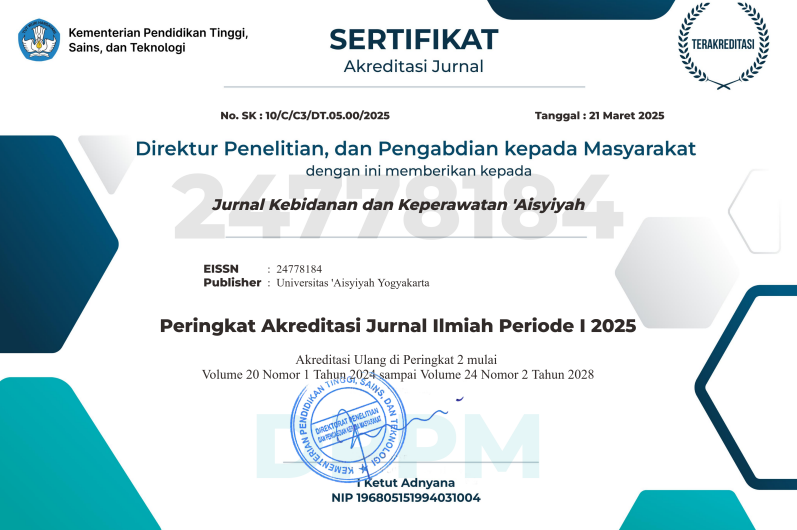Sikap Perawat dalam Memberikan Asuhan Keperawatan pada Pasien Paliatif
DOI:
https://doi.org/10.31101/jkk.1782Abstract views 3161 times
Keywords:
sikap perawat, asuhan keperawatan, kemoterapi, paliatifAbstract
Downloads
References
Alvariza, A., Mjörnberg, M., & Goliath, I. (2020). Palliative care nurses’ strategies when working in private homes—A photo-elicitation study. Journal of Clinical Nursing, 29(1–2), 139–151. https://doi.org/https://doi.org/10.1111/jocn.15072
Ayed, A., Sayej, S., Harazneh, L., Fashafsheh, I., & Eqtait, F. (2015). The Nurses’ Knowledge and Attitudes towards the Palliative Care. Journal of Education and Paratice, 6(4), 91–100. www.iiste.org
Benzaid, M., Lahrichi, N., & Rousseau, L.-M. (2020). Chemotherapy appointment scheduling and daily outpatient–nurse assignment. Health Care Management Science, 23(1), 34–50. https://doi.org/10.1007/s10729-018-9462-6
Choudhary, V. S. (2016). Assessment of the Knowledge and Attitudes of Staff Nurses on Nursing Care of Cancer Patients Undergoing Chemotherapy at Selected Cancer Hospitals of Punjab. Nursing & Care Open Access Journal, 1(2), 18–24. https://doi.org/10.15406/ncoaj.2016.01.00009
Dehghani, F., Barkhordari-Sharifabad, M., Sedaghati-Kasbakhi, M., & Fallahzadeh, H. (2020). Effect of palliative care training on perceived self-efficacy of the nurses. BMC Palliative Care, 19(1), 1–6. https://doi.org/10.1186/s12904-020-00567-4
Fauziningtyas, R., Indarwati, R., & Asmoro, C. P. (2020). Determinants of Knowledge and Attitude related to Palliative Care Nurses. 24(June), 1–10.
Ford, J., Hepburn, A., & Parry, R. (2019). What do displays of empathy do in palliative care consultations? Discourse Studies, 21(1), 22–37. https://doi.org/10.1177/1461445618814030
Frey, R., Balmer, D., Boyd, M., Robinson, J., & Gott, M. (2019). Palliative care nurse specialists’ reflections on a palliative care educational intervention in long-term care: An inductive content analysis. BMC Palliative Care, 18(1), 1–9. https://doi.org/10.1186/s12904-019-0488-4
Fulton, J. S. (2014). The future of complex care. Clinical Nurse Specialist CNS, 28(4), 195–196. https://doi.org/10.1097/01.NUR.0000451064.21061.25
Glasdam, S., Ekstrand, F., Rosberg, M., & van der Schaaf, A. M. (2020). A gap between the philosophy and the practice of palliative healthcare: sociological perspectives on the practice of nurses in specialised palliative homecare. Medicine, Health Care and Philosophy, 23(1), 141–152. https://doi.org/10.1007/s11019-019-09918-2
Guerrero, J. G. (2019). Nurses towards End-of-Life Situations: Sympathy vs. Empathy. Open Journal of Nursing, 09(03), 278–293. https://doi.org/10.4236/ojn.2019.93027
Hickman, S. E., Parks, M., Unroe, K. T., Ott, M., & Ersek, M. (2020). The Role of the Palliative Care Registered Nurse in the Nursing Facility Setting. Journal of Hospice & Palliative Nursing, 22(2). https://journals.lww.com/jhpn/Fulltext/2020/04000/The_Role_of_the_Palliative_Care_Registered_Nurse.11.aspx
IAHPC. (2013). The iahpc manual of palliative care, 3rd edition. Journal of Pain and Palliative Care Pharmacotherapy, 27(4), 408–409. https://doi.org/10.3109/15360288.2013.848970
Kapucu, S., & Bagcivan, G. (2017). Knowledge Level on Administration of Chemotherapy through Peripheral and Central Venous Catheter among Oncology Nurses. 61–68. https://doi.org/10.4103/2347-5625.199081
KemenkesRi. (2015). KMK 10. 241–272.
Khan, N., Khowaja, K. Z. A., & Ali, T. S. (2012). Assessment of knowledge, skill and attitude of oncology nurses in chemotherapy administration in tertiary hospital Pakistan. Open Journal of Nursing, 02(02), 97–103. https://doi.org/10.4236/ojn.2012.22015
Kim, S., Lee, K., & Kim, S. (2020). Knowledge, attitude, confidence, and educational needs of palliative care in nurses caring for non-cancer patients: A cross-sectional, descriptive study. BMC Palliative Care, 19(1), 1–14. https://doi.org/10.1186/s12904-020-00581-6
Koper, I., Pasman, H. R. W., Schweitzer, B. P. M., Kuin, A., & Onwuteaka-Philipsen, B. D. (2019). Spiritual care at the end of life in the primary care setting: Experiences from spiritual caregivers-A mixed methods study. BMC Palliative Care, 18(1), 1–10. https://doi.org/10.1186/s12904-019-0484-8
Lee, J. E., & Sim, I. O. (2020). Gap between college education and clinical practice: Experience of newly graduated nurses. Nursing Open, 7(1), 449–456. https://doi.org/https://doi.org/10.1002/nop2.409
Ligita, T. (2017). Home Care Nurses’ Roles in Enhancing Quality of Nursing Care for Patients At Home: a Phenomenological Study. Belitung Nursing Journal, 3(4), 345–351. https://doi.org/10.33546/bnj.90
Lukewich, J. A., Tranmer, J. E., Kirkland, M. C., & Walsh, A. J. (2019). Exploring the utility of the Nursing Role Effectiveness Model in evaluating nursing contributions in primary health care: A scoping review. Nursing Open, 6(3), 685–697. https://doi.org/10.1002/nop2.281
Maulida,Mutia Nadra; Oktadini, Nabila Rizky; Purnamasari, N. (2017). GAMBARAN PENGETAHUAN DAN SIKAP PERAWAT MENGENAI PERAWATAN PALIATIF. Implikasi Perawatan Paliatif Pada Bidang Kesehatan, 132–136.
Mitrea, N., Ancuta, C., Malloy, P., & Mosoiu, D. (2019). Developing, Promoting, and Sustaining Palliative Care Across Central Eastern Europe: Educating Nurses to Be Leaders Is a Critical First Step. Journal of Hospice & Palliative Nursing, 21(6). https://journals.lww.com/jhpn/Fulltext/2019/12000/Developing,_Promoting,_and_Sustaining_Palliative.9.aspx
Mizuno, A., Shibata, T., & Oishi, S. (2019). The essence of palliative care is best viewed as the “problematization.†Journal of Palliative Medicine, 22(1), 6. https://doi.org/10.1089/jpm.2018.0501
Moudatsou, M., Stavropoulou, A., Philalithis, A., & Koukouli, S. (2020). The Role of Empathy in Health and Social Care Professionals. Healthcare, 8(1), 26. https://doi.org/10.3390/healthcare8010026
Mudd, A., Feo, R., Conroy, T., & Kitson, A. (2020). Where and how does fundamental care fit within seminal nursing theories: A narrative review and synthesis of key nursing concepts. Journal of Clinical Nursing, 29(19–20), 3652–3666. https://doi.org/https://doi.org/10.1111/jocn.15420
Muhammed Emin, G., Onur, Ö., & Mustafa, Ü. (2020). Palliative care approach to oncological patient – Main points. Archives of Cancer Science and Therapy, 4(1), 015–016. https://doi.org/10.29328/journal.acst.1001015
O’Mahony, S., Baron, A., Ansari, A., Deamant, C., Nelson-Becker, H., Fitchett, G., & Levine, S. (2020). Expanding the Interdisciplinary Palliative Medicine Workforce: A Longitudinal Education and Mentoring Program for Practicing Clinicians. Journal of Pain and Symptom Management, 60(3), 602–612. https://doi.org/https://doi.org/10.1016/j.jpainsymman.2020.03.036
Powell, M. J., Froggatt, K., & Giga, S. (2020). Resilience in inpatient palliative care nursing: a qualitative systematic review. BMJ Supportive &Amp; Palliative Care, 10(1), 79 LP – 90. https://doi.org/10.1136/bmjspcare-2018-001693
Riahi, S., & Khajehei, M. (2019). Palliative Care: A Systematic Review of Evidence-Based Interventions. Critical Care Nursing Quarterly, 42(3). https://journals.lww.com/ccnq/Fulltext/2019/07000/Palliative_Care__A_Systematic_Review_of.12.aspx
Riskesdas. (2018). Hasil Utama Riset Kesehata Dasar (RISKESDAS). Journal of Physics A: Mathematical and Theoretical, 44(8), 1–200. https://doi.org/10.1088/1751-8113/44/8/085201
Rodin, G., An, E., Shnall, J., & Malfitano, C. (2020). Psychological Interventions for Patients With Advanced Disease: Implications for Oncology and Palliative Care. Journal of Clinical Oncology, 38(9), 885–904. https://doi.org/10.1200/JCO.19.00058
Ruiz-Junco, N., & Morrison, D. R. (2019). Empathy as Care: the Model of Palliative Medicine. Society, 56(2), 158–165. https://doi.org/10.1007/s12115-019-00344-x
Rusdi, A. R. N., Russeng, S. S., Salmah, A. U., Wahyu, A., Mallongi, A., & Yanti, I. H. (2020). The influence of workload on the nurses performance at Ambon general hospital. EnfermerÃa ClÃnica, 30, 419–422. https://doi.org/https://doi.org/10.1016/j.enfcli.2019.10.114
Signorelli, T. (2020). Dynamic nurse assignment in chemotherapy outpatient clinics Dynamic Nurse Assignment in Chemotherapy Outpatient Clinics.
WHO. (2018). WHO guidelines for the pharmacological and radiotherapeutic management of cancer pain in adults and adolescents. In World Health Organization.
World Palliative Care Alliance. (2014). Global atlas of palliative care at the end of life (Issue January). http://www.who.int/cancer/publications/palliative-care-atlas/en/
YKI. (2017). Dalam Spirirt, Kita bisa, saya bisa.
Downloads
Published
How to Cite
Issue
Section
License
With the receipt of the article by the Jurnal Kebidanan dan Keperawatan Aisyiyah Editorial Board and the decision to be published, then the copyright regarding the article will be diverted to Jurnal Kebidanan dan Keperawatan Aisyiyah. Universitas 'Aisyiyah Yogyakarta as the publisher of Jurnal Kebidanan dan Keperawatan Aisyiyah hold the copyright regarding all the published articles in this journal.
Jurnal Kebidanan dan Keperawatan Aisyiyah is licensed under a Creative Commons Attribution-ShareAlike 4.0 International License.
















